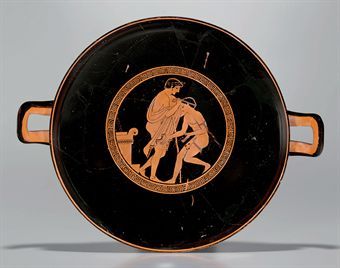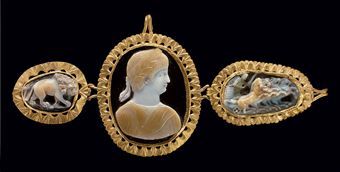Christie's to Present Important Auctions of Antiquities and Ancient Jewelry in December
A Roman Marble Torso of a God or an Athlete, Circa 1st Century B.C.-1st Century A.D. Estimate: $300,000 - 500,000. Photo: Christie's Images Ltd 2010
NEW YORK, NY.- Christie’s will offer two sales of ancient art that will take place on December 9- Antiquities Including Property from the Collection of Max Palevsky and Ancient Jewelry. The sales will feature over 300 lots that range from Predynastic Egypt through to the Byzantine period, including a highly important Cycladic marble reclining female figure. Highlights comprise an exquisite Roman marble torso of an emperor, an Egyptian red granite statue of a queen and an exceptional suite of three Roman gold-mounted sardonyx cameos.
A SELECTION OF HIGHLIGHTS
EGYPT
An Egyptian Red Granite Statue Of Queen Late Ptolemaic Period, Circa 1ST Century B.C. Estimate: $200,000 - 300,000. Photo: Christie's Images Ltd 2010
An Egyptian red granite statue of a queen possibly depicting Cleopatra VII, striding forward in the traditional Egyptian stance. This queen in its present form may have originally been carved for an earlier queen, likely Karomama, the wife of the Dynasty XXII Pharaoh Osorkon II (924-909 B.C.), the statue was recarved in the Ptolemaic Period with the visage of a different queen, most likely Cleopatra VII.
Also included in the Egyptian section is a large Egyptian bronze falcon-headed Horus, Ptolemaic Period, 304-30 B.C (estimate: $150,000 - $250,000); and an Egyptian bronze standard finial, in the form of the jackal Wepwawet, New Kingdom to Third Intermediate Period, Dynasty XVII-XXV, 1550-712 B.C. (estimate: $200,000 - $300,000), finely executed with extreme elegance.
NEAR EAST
A Babylonian Gray Stone Kudurru Second Dynasty of Isin, Reign of Nebuchadnezzar I, 1126-1105 B.C. Estimate: $150,000 - 250,000. Photo: Christie's Images Ltd 2010
Leading the Near East selection of works is a Babylonian Gray Stone Kudurru, Second Dynasty of Isin, Reign of Nebuchadnezzar I, 1126-1105 B.C. A kudurru, or boundary stone, was set up in a temple to record a land grant by the king, which curses any later official who tried to undo the arrangement. Most date to the end of the Kassite period and continue into the early 1st millennium B.C.
GLASS
A Mesopotamian Core-Formed Glass Bottle. Circa Mid to Late 15th Century B.C. Estimate: $150,000 - 250,000. Photo: Christie's Images Ltd 2010
Colored with a vibrant opaque cobalt blue hue, this cylindrical bottle is an exceptional example of an extremely early glass vessel. Like this glass bottle, the first glass vessels ever produced were made in northern Mesopotamia in the late 16th and early 15th centuries B.C. all by the core-form method.
CYCLADIC
A Cycladic marble reclining female figure, Name-piece of the Schuster Master, Early Cycladic II Circa 2400 B.C. Estimate: $3-5 million. Photo: Christie's Images Ltd 2010
Christie’s is pleased to offer a Cycladic marble reclining female figure, the most important Cycladic idol ever to come to auction. Estimated at $3-5 million, the folded-arm female figure is one of the most iconic sculptural types to have survived from antiquity. To date, there are only twelve known sculptures that have been recognized as the work of a single artist today known as the Schuster Master, named after the previous owner of the present work, Marion Schuster. Most of Schuster Master’s works represent the female in a pregnant state.
GREEK
An Attic Red-Figured Kylix Attributed to The Colmar Painter, Circa 490 B.C. Estimate: $150,000 - 250,000. Photo: Christie's Images Ltd 2010
The tondo of this very fine cup, a late work by the artist, is thought to show a youth crowning a victor of the euandria, a tribal contest limited to Athenian citizens, which was part of the Panathenaic Games. The Colmar Painter was a late Archaic cup-painter whose style was developed under the influence of Onesimos and the Antiphon Painter, who very likely sat with them in the workshop of Euphronios.
Also among the Greek highlights is a Greek bronze corslet, circa late 7th- early 6th century B.C. (estimate: $80,000-120,000); a Greek bronze winged helmet of Chalcidian Type, late Classical Period, circa 4th century B.C. (estimate: $50,000-80,000); and a Greek parcel gilt silver mirror, Hellenistic Period, circa 2nd-1st century B.C. (estimate: $70,000-90,000)
ROMAN
A Roman Marble Emperor. Circa Late 1st–Early 2nd Century A.D. Estimate: $600,000 - 900,000. Photo: Christie's Images Ltd 2010
Among the extraordinary works from the Roman period is a Roman marble emperor circa Late 1st–Early 2nd Century A.D. (estimate: $600,000-900,000). This statue likely depicts the Emperor Trajan, representing him in full military regalia.
Property from the Collection of Max Palevsky A Roman Marble Head of Aphrodite. Circa 1st- 2nd Century A.D. Estimate: $150,000-250,000. Photo: Christie's Images Ltd 2010
Born in Chicago, Max Palevsky (1924-2010) was an innovator and forerunner in computers and systems technology. His work continues to influence computing technology today. The Collection of Max Palevsky comprises Antiquities, Impressionist and Modern Art, Post-War and Contemporary Art, 20th Century Decorative Arts and Design, Prints and Multiples, Japanese Art, Latin American Art, American Sculpture and Modern British Art. Offered in this sale are seven works from the Collection of Max Palevsky, including four remarkable Roman marble sculptures, including: a Roman marble Athena, circa 1st-2nd Century A.D (estimate: $200,000-300,000), a Roman marble head of Aphrodite, circa 1st-2nd Century A.D. (estimate: $150,000-250,000) and a Roman marble draped female Herm, circa 1st-2nd century A.D. (estimate: $250,000-350,000).
ANCIENT JEWELRY
Three Roman Gold-Mounted Sardonyx Cameos. Circa 1st-2nd Century A.D. and 3rd Century A.D. Estimate: $150,000 - 250,000. Photo: Christie's Images Ltd 2010
It was common during the later Roman Empire for jewelers to re-use older stones in their work. The magnificent 1st century A.D. cameo centering this ensemble depicts a youthful Emperor Nero, whose memory had been officially condemned at the end of his tumultuous reign. This suggests that by the 3rd century, when the cameo was remounted, either that his physiognomy was no longer recognized, or that his popularity endured despite his condemnation.
A Byzantine Gold, Pearl, Emerald And Spinel Cross. Circa 6th-Early 7th Century A.D. Estimate: $40,000 - 60,000. Photo: Christie's Images Ltd 2010
The extremely high quality of workmanship and materials suggests that this cross was produced in an Imperial workshop in Constantinople. The emeralds are of the highest quality, imported from Egypt. The spinel is likely from Ceylon or Madagascar. The natural seed pearls are most likely from the Gulf or India.
Auction:
Antiquities including Property from the Collection of Max Palevsky Dec 9 Ancient Jewelry Dec 9
Viewing:
Christie's Rockefeller Galleries Dec 4- 9

/https%3A%2F%2Fprofilepics.canalblog.com%2Fprofilepics%2F1%2F0%2F100183.jpg)
/https%3A%2F%2Fstorage.canalblog.com%2F03%2F02%2F119589%2F96711876_o.jpg)
/https%3A%2F%2Fstorage.canalblog.com%2F11%2F31%2F119589%2F94773502_o.jpg)
/https%3A%2F%2Fstorage.canalblog.com%2F20%2F83%2F119589%2F94772815_o.jpg)
/https%3A%2F%2Fstorage.canalblog.com%2F26%2F72%2F119589%2F75604929_o.jpg)
/https%3A%2F%2Fstorage.canalblog.com%2F59%2F60%2F119589%2F26458628_o.jpg)












/http%3A%2F%2Fstorage.canalblog.com%2F47%2F82%2F119589%2F127772016_o.jpg)
/http%3A%2F%2Fstorage.canalblog.com%2F46%2F16%2F119589%2F122392028_o.jpg)
/http%3A%2F%2Fstorage.canalblog.com%2F20%2F19%2F119589%2F120625079_o.jpeg)
/http%3A%2F%2Fstorage.canalblog.com%2F20%2F86%2F119589%2F120616936_o.jpg)